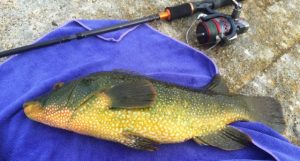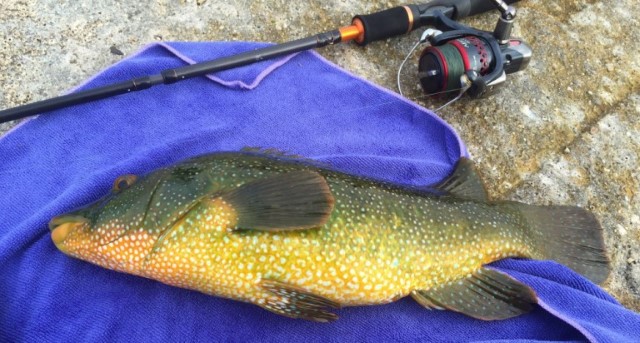Members of the public fishing recreationally should be extremely concerned over a new and rapidly expanding commercial fishery which threatens the South West’s wrasse populations.
The Angling Trust is calling for an immediate suspension of the fishery supplying live, wild-caught wrasse to the salmon aquaculture market where they are used to remove parasitic sea lice from farmed salmon.
Official government figures from the Marine Management Organisation (MMO) show that in 2015 89 tonnes of wrasse species were caught and used as cleaner fish as an alternative to traditional pesticides to manage sea lice numbers.
Many of the wrasse are being taken from the inshore waters of the South West of England. Wrasse are highly important recreational angling species and play an important role in the resident and tourist angling activity which supports thousands of jobs throughout the South West of England and which was valued at £165m to the regional economy back in 2005 (1). Generations of young anglers fish for wrasse as they enter the sport and recent years have seen an exciting new development of specialist lure angling for wrasse.
Landings data from the MMO (2) shows that the value of live, wild-caught wrasse at prices as high as £150 per kilo makes what used to be a ‘trash fish’, or one only used as pot bait, the single most valuable wild capture fishery in the UK compared to wild sea bass and lobster that can fetch as much as £15 -17 per kilo.
With no controls on how much can be caught, and very little known about the impact on wrasse stocks and the ecosystem, sea anglers are hugely concerned that wrasse stocks in English waters could be decimated by the rush to profit from this hugely valuable, yet totally unmanaged, fishery.
Little is known about the sustainability of wrasse populations and what impact commercial scale harvesting will have on marine ecosystems where wrasse play an important role. However, anecdotal evidence suggests the hugely expensive operation of shipping wrasse live from the South West of England to Scotland is only necessary because localised Scottish wrasse stocks have already been depleted by the demand from salmon farms.
Official figures from the MMO add to the confusion about the extent of the wrasse fishery with the aggregated monthly landings for 2015 being reported as 89 tonnes with a value of £5m (3) and the annual statistical report for the same period reporting over 40 tonnes landings valued at £1.1m (4). Yet despite the huge discrepancies in MMO data being drawn to their attention the MMO have not been able to provide any explanation but it is clearly a very significant new fishery. More accurate data at local level are also hard to come by.
 The Angling Trust is writing to the MMO, the Inshore Fishery and Conservation Authorities (IFCAs) and the Welsh Assembly Government to request immediate measures to stop the live capture of wild wrasse for the aquaculture market using the precautionary approach under section 153 of the Marine & Coastal Access Act until there is sufficient evidence to establish: 1) whether it is sustainable, 2) what impact the removal of wrasse has on the ecosystem, and 3) whether the removal of an important recreational asset for anglers in the South West of England to supply the Scottish aquaculture market is in line with the IFCAs’ obligation to manage sea fishery resources sustainably. In addition, the Angling Trust is calling on the use of wild-caught ‘cleaner’ fish to be included in the environmental impact assessments of any aquaculture operations.
The Angling Trust is writing to the MMO, the Inshore Fishery and Conservation Authorities (IFCAs) and the Welsh Assembly Government to request immediate measures to stop the live capture of wild wrasse for the aquaculture market using the precautionary approach under section 153 of the Marine & Coastal Access Act until there is sufficient evidence to establish: 1) whether it is sustainable, 2) what impact the removal of wrasse has on the ecosystem, and 3) whether the removal of an important recreational asset for anglers in the South West of England to supply the Scottish aquaculture market is in line with the IFCAs’ obligation to manage sea fishery resources sustainably. In addition, the Angling Trust is calling on the use of wild-caught ‘cleaner’ fish to be included in the environmental impact assessments of any aquaculture operations.
The Angling Trust has repeatedly called on the salmon farming industry to increase the pace of movement towards farming salmon in closed containment systems to keep them away from wild fish and the naturally occurring parasitic sea lice. The decline of wild sea trout and salmon stocks throughout the West coast of Scotland and beyond has been clearly linked with infestations of sea lice from salmon farms. Chemical treatments of farmed fish have been increasing rapidly and diversifying in recent years due to resistance building up in sea lice populations.
Attempts are being made to supply the aquaculture market with captive bred wrasse. However, the complicated lifecycle of wrasse means that this is still far from being a reality at a significant scale. The general public should be alarmed that wrasse stocks could be destroyed by uncontrolled commercial fishing pressure and a lack of control measures from fisheries managers.
David Mitchell, the Angling Trust’s Head of Marine, said; “Members of the public fishing recreationally for publicly-owned wrasse stocks in South West England will be appalled to learn that wrasse, once of no commercial value but a highly valuable species to those fishing recreationally, are now being targeted and transported live up to Scotland to help remove sea lice from the environmentally damaging salmon farming industry. The impact of this rapidly expanding fishery on localised wrasse stocks, and on the functioning of the ecosystem, is currently unknown. Precautionary measures must be taken to stop this emerging and unmanaged fishery from wiping out vulnerable wrasse populations before the impact and sustainability of the fishery can be established.”
Malcolm Gilbert, Conservation Officer for the Cornish Federation of Sea Anglers, said; “Alarm bells are already ringing throughout the recreational angling community. Anglers were denied keeping any bass to eat for the first half of 2016 and are again in 2017, with a one bass bag limit for second half of the year. Yet it was anglers who have consistently demanded from government a more restrictive management approach for what was primarily an angling species before the escalation of commercial fishing threatened stocks. Will wrasse be next in line?”











